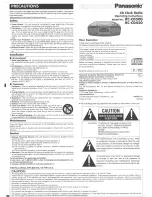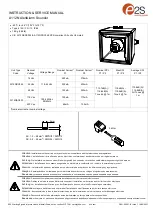
Engine Noise Suppression
Interference from the noise generated by the electrical systems of engines is sometimes a problem with radios. Your radio has been
designed to be essentially impervious to ignition noise and alternator noise. However, in some installations it may be necessary to
take measures to further reduce the effect of noise interference. Your radio’s DC battery wires, antenna lead, and accessory cables
should be routed away from the engine and engine compartment, and from power cabling carrying high currents. In severe cases of
noise interference, it may be necessary to install a noise suppression kit. Contact the dealer where you purchased the radio for more
information.
SPECIFICATIONS
All specifications are subject to change without notice.
Radio Specifications
General
Controls
Volume-Pwr, Squelch
Status Indicators
Transmit power, Scan mode, Triple Watch mode, Battery High, Battery low, USA, CAN, INT, Alert,
Memory, GPS, Message, Weather band, GPS status and Channel Display
Display
LCD (Full Dot Matrix)
Buttons
ENT-1W/25W, Channel UP, Channel DOWN, CALL-MENU, WX-MEM, CLR-SCAN, 16/9-TRI, and
DISTRESS
Connectors and Cables
Antenna, accessory, and DC power
Size
H 75 mm x W 167 mm x L 129 mm (without Heat Sink)
H 2.95 inches x W 6.58 inches x L 5.08 inches
Weight
1.0 kg (2.2 pounds)
Supply Voltage
Nominal 13.8V DC, negative ground (10.5 VDC to 16.0 VDC)
Standard Accessories
Mounting bracket and hardware, microphone hanger,
Antenna Impedance
50 Ω nominal
Microphone
Rugged 2 kΩ condenser mic element with coiled cord
Speaker
1.77 inch, 8 Ω
Operating Temperature Range
–20 °C to + 50 °C (–4 °F to +122 °F)
Shock and Vibration
Meets or exceeds EIA standards, RS152B and RS204C
FCC Approvals
Type accepted under part 80 of the Rules; meets Great Lakes Agreement and party boat
requirements
Transmitter
Power Output
1 watt or 25 watt (user selectable)
Power Requirement
25 watts output: [email protected] DC
Modulation
±5 kHz deviation
Hum and Noise Signal-to-Noise
50 dB@1 kHz with 3 kHz deviation with 1000 Hz modulating frequency (nominal)
Audio Distortion
Less than 8% with 3 kHz deviation with 1000 Hz modulating frequency
Spurious Suppression
–45 dBm @ Hi, –55 dBm @ Lo
Output Power Stabilization
Built-in automatic level control (ALC)
Frequency Range
156 to 163 MHz
Frequency Stability
±10 ppm @ –20°C to + 50°C
Receiver
Frequency Range
156 to 163 MHz
Sensitivity
0.25 μV for 12 dB SINAD (nominal)
Circuit
Dual Conversion Super Heterodyne PLL (Crystal for DSC)
Squelch Sensitivity
0.2 μV Threshold
VHF595 RADIO
1-800-BOATING
27














































